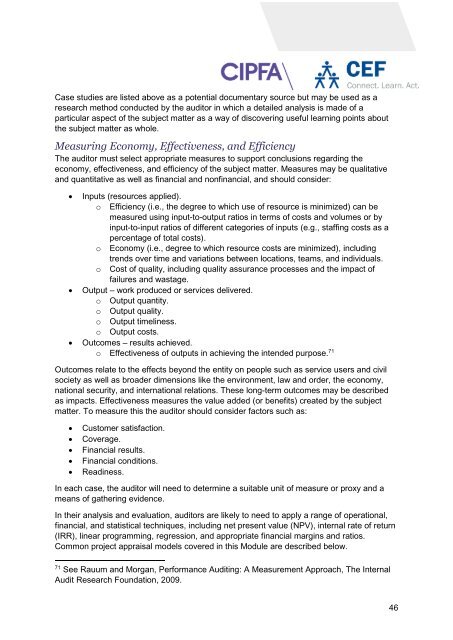Module 4 - Introduction to Performance Audit_4C
Create successful ePaper yourself
Turn your PDF publications into a flip-book with our unique Google optimized e-Paper software.
Case studies are listed above as a potential documentary source but may be used as a<br />
research method conducted by the audi<strong>to</strong>r in which a detailed analysis is made of a<br />
particular aspect of the subject matter as a way of discovering useful learning points about<br />
the subject matter as whole.<br />
Measuring Economy, Effectiveness, and Efficiency<br />
The audi<strong>to</strong>r must select appropriate measures <strong>to</strong> support conclusions regarding the<br />
economy, effectiveness, and efficiency of the subject matter. Measures may be qualitative<br />
and quantitative as well as financial and nonfinancial, and should consider:<br />
<br />
<br />
<br />
Inputs (resources applied).<br />
o Efficiency (i.e., the degree <strong>to</strong> which use of resource is minimized) can be<br />
measured using input-<strong>to</strong>-output ratios in terms of costs and volumes or by<br />
input-<strong>to</strong>-input ratios of different categories of inputs (e.g., staffing costs as a<br />
percentage of <strong>to</strong>tal costs).<br />
o Economy (i.e., degree <strong>to</strong> which resource costs are minimized), including<br />
trends over time and variations between locations, teams, and individuals.<br />
o Cost of quality, including quality assurance processes and the impact of<br />
failures and wastage.<br />
Output – work produced or services delivered.<br />
o Output quantity.<br />
o Output quality.<br />
o Output timeliness.<br />
o Output costs.<br />
Outcomes – results achieved.<br />
o Effectiveness of outputs in achieving the intended purpose. 71<br />
Outcomes relate <strong>to</strong> the effects beyond the entity on people such as service users and civil<br />
society as well as broader dimensions like the environment, law and order, the economy,<br />
national security, and international relations. These long-term outcomes may be described<br />
as impacts. Effectiveness measures the value added (or benefits) created by the subject<br />
matter. To measure this the audi<strong>to</strong>r should consider fac<strong>to</strong>rs such as:<br />
<br />
<br />
<br />
<br />
<br />
Cus<strong>to</strong>mer satisfaction.<br />
Coverage.<br />
Financial results.<br />
Financial conditions.<br />
Readiness.<br />
In each case, the audi<strong>to</strong>r will need <strong>to</strong> determine a suitable unit of measure or proxy and a<br />
means of gathering evidence.<br />
In their analysis and evaluation, audi<strong>to</strong>rs are likely <strong>to</strong> need <strong>to</strong> apply a range of operational,<br />
financial, and statistical techniques, including net present value (NPV), internal rate of return<br />
(IRR), linear programming, regression, and appropriate financial margins and ratios.<br />
Common project appraisal models covered in this <strong>Module</strong> are described below.<br />
71<br />
See Rauum and Morgan, <strong>Performance</strong> <strong>Audit</strong>ing: A Measurement Approach, The Internal<br />
<strong>Audit</strong> Research Foundation, 2009.<br />
46
















